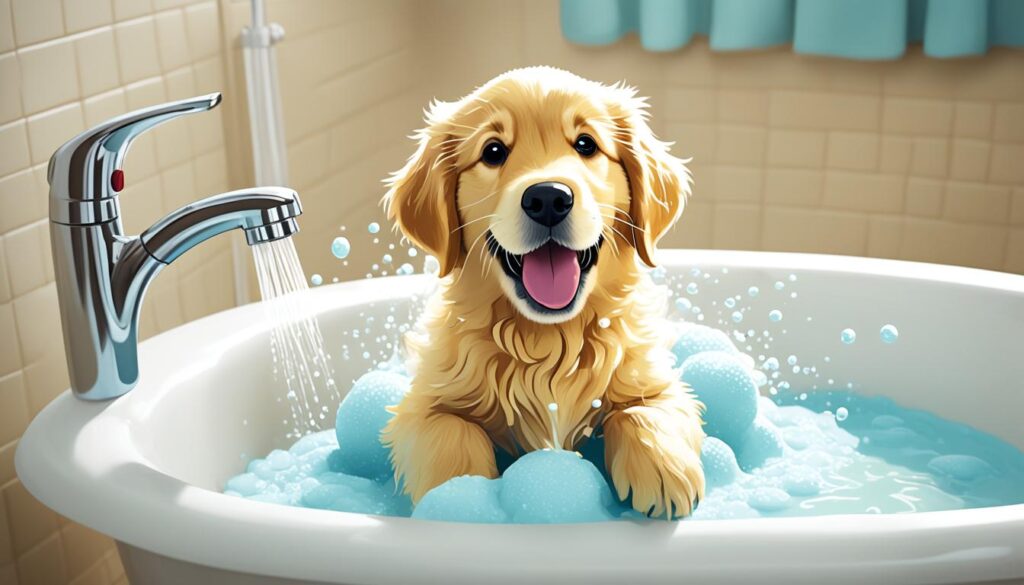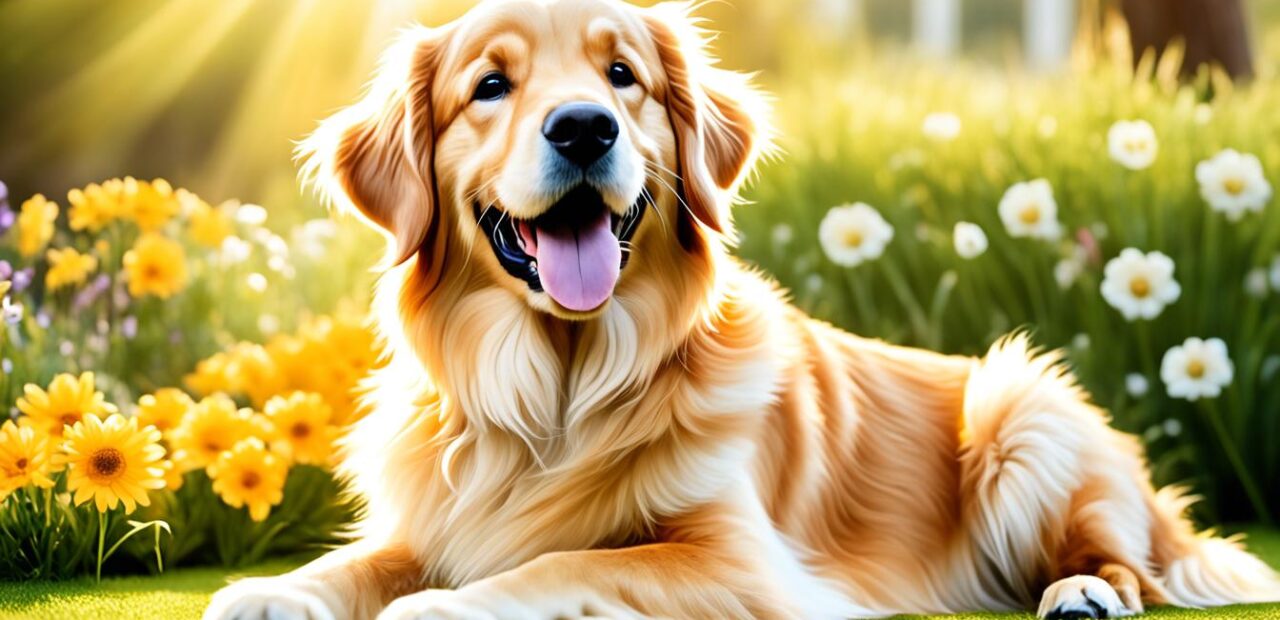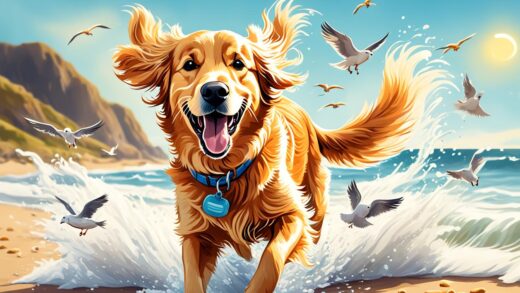Grooming Goals: A Shiny Coat for Your Furry Friend
Did you know that a healthy dog’s coat can shed up to 1000 hairs per day? That’s equivalent to filling an entire pillowcase every month! Taking care of your dog’s coat is not just about aesthetics; it’s a crucial part of their overall health and well-being. A shiny coat signifies good health, while a dull or brittle one may indicate underlying issues.
From proper nutrition to regular grooming, there are several steps you can take to ensure your furry friend sports a shiny and lustrous coat. By following these dog grooming tips and incorporating them into your routine, you can keep your dog’s coat healthy, vibrant, and free from common issues like dandruff and excessive shedding.
Key Takeaways:
- A shiny coat is an indicator of good overall health in dogs
- Proper nutrition is essential for a healthy and shiny coat
- Regular grooming, including brushing and bathing, helps stimulate natural oils and keeps the coat glossy
- Using the right grooming tools ensures efficient removal of loose fur and tangles
- Consulting a veterinarian can help address any specific coat health concerns or recommend suitable supplements
Brushing Up: Essential Tools and Techniques
Regular brushing is key to managing shedding and maintaining a healthy coat. When it comes to dog brushing, different breeds require different types of grooming tools and techniques to keep their coats in top condition.
Choosing the Right Tools
Having the right grooming tools is essential for effective brushing. Here are some commonly used tools based on coat types:
| Coat Type | Recommended Brush |
|---|---|
| Long-haired Breeds | Slicker brushes for removing mats and tangles |
| Short-haired Dogs | Bristle brushes for gentle grooming |
| Heavy Shedders | Deshedding tools to reduce shedding |
Using the appropriate brush ensures efficient removal of loose hair and promotes a healthy coat. Regular brushing with the right tools can prevent matting, tangles, and excessive shedding.
Brushing Techniques
When brushing your dog, it’s important to follow the right techniques:
- Brush in the direction of hair growth to avoid discomfort for your furry friend.
- Start with a gentle touch and gradually increase pressure to remove tangles and mats.
- Make brushing a positive experience by incorporating treats, praise, and frequent breaks for dogs who may be anxious or fearful.
Consistency is key when it comes to brushing. The frequency of brushing depends on your dog’s coat type:
- Short-haired dogs: Every two days for regular maintenance
- Medium-haired dogs: Two to three times a week for upkeep
- Long-haired or double-coated dogs: Daily or every other day for thorough brushing
Establishing a regular grooming routine ensures your dog’s coat stays healthy and free from tangles, mats, and excess hair.
Remember, in addition to maintaining a shiny coat, brushing also provides an opportunity for bonding and strengthening the relationship between you and your beloved dog.
Bath Time Tips for a Shiny Coat
Bathing your dog is an essential part of maintaining a healthy and shiny coat. By following the right techniques and using the appropriate shampoo, you can ensure that your furry friend’s coat retains its natural radiance.
When it comes to choosing a shampoo, opt for ones that are specifically formulated for dogs and are gentle on their skin. Look for moisturizing shampoos that are free from harsh chemicals and artificial ingredients. These gentle formulations will help nourish your dog’s skin and keep their coat hydrated.
Prior to bathing, it’s a good idea to brush your dog’s coat to remove any loose fur or mats. This will make the bathing process more effective and prevent further tangles or matting.
During the bath, use a deshedding shampoo to help reduce shedding and promote a healthy coat. These shampoos are designed to remove loose hair and minimize excessive shedding. Be sure to thoroughly rinse your dog’s coat to avoid any residue that might cause skin irritation.
To complete the bathing process, gently dry your dog using a towel. Avoid using a high-heat setting on a blow dryer, as it can damage their skin and coat. Instead, use a low or cool setting to prevent dryness and frizz. This gentle drying method will help maintain the natural oils in their coat and keep it looking shiny and lustrous.
After bathing, take the time to brush your dog’s coat again. This will help remove any remaining loose fur and promote healthy hair growth. Regular brushing will also improve blood circulation, which is beneficial for overall coat health.
Key Bathing Techniques:
- Choose a gentle, dog-specific shampoo that moisturizes and is free from harsh chemicals.
- Brush your dog’s coat before bathing to remove loose fur and mats.
- Use a deshedding shampoo during the bath to minimize shedding.
- Thoroughly rinse your dog’s coat to avoid any skin irritation.
- Gently dry your dog with a towel and avoid high-heat blow dryers.
- After-bath brushing removes any remaining loose fur and promotes healthy hair growth.
| Shampoo Features | Benefits |
|---|---|
| Gentle on the skin | Prevents irritation and maintains coat health |
| Moisturizes | Keeps the coat hydrated and prevents dryness |
| Free from harsh chemicals | Avoids unnecessary exposure to harmful ingredients |

Nutrition and Supplements for a Shiny Coat
The right diet plays a crucial role in maintaining a shiny coat for your dog. A balanced diet rich in proteins, omega-3 and omega-6 fatty acids, and other essential nutrients can promote coat health. Foods that promote a healthy coat include salmon, sweet potatoes, eggs, blueberries, and spinach. It is important to consult with a veterinarian before making any significant changes to your dog’s diet. Supplements like omega-3 and omega-6 fatty acid supplements, biotin, zinc, and vitamin E can also help reduce excessive shedding and promote a shiny coat. Regular grooming, including brushing and bathing, remains essential even with a proper diet and supplements.
“A balanced diet rich in proteins, omega-3 and omega-6 fatty acids, and other essential nutrients can promote coat health.”
Ensuring that your dog has a well-rounded and nutrient-rich diet is essential for maintaining a shiny and healthy coat. Proteins are the building blocks of a dog’s coat, providing the necessary amino acids for coat growth and strength. Omega-3 and omega-6 fatty acids are essential for maintaining and nourishing the skin and coat, reducing inflammation, and promoting optimal coat health. Foods that are high in these nutrients, such as salmon, can provide significant benefits to your dog’s coat.
In addition to proteins and fatty acids, other essential nutrients like biotin, zinc, and vitamin E also play a crucial role in maintaining a shiny coat. Biotin is a B-vitamin that supports healthy skin and coat, while zinc is essential for protein synthesis and cell division, contributing to coat growth and quality. Vitamin E is a powerful antioxidant that helps protect the skin and coat from damage caused by free radicals.
While a balanced diet should be the primary source of these essential nutrients, supplements can be useful in certain cases. If your dog’s coat health is compromised or if they have excessive shedding, incorporating supplements like omega-3 and omega-6 fatty acids, biotin, zinc, and vitamin E can help promote a shiny coat. However, it is crucial to consult with a veterinarian before introducing any supplements into your dog’s diet, as they can provide personalized recommendations based on your dog’s specific needs.
In conclusion, a nutritious diet and appropriate supplementation can greatly contribute to a shiny coat for your dog. However, it is essential to remember that proper grooming practices, including regular brushing and bathing, remain an integral part of coat care. By combining a balanced diet, appropriate supplements, and regular grooming, you can help your furry friend achieve and maintain a vibrant and healthy coat.
Conclusion
Achieving and maintaining a shiny coat for your dog requires a holistic approach that incorporates a balanced diet, regular grooming, and appropriate care. A shiny coat not only enhances your furry friend’s appearance but also serves as an indicator of their overall health. By providing your dog with a nutritious diet rich in proteins, omega-3 fatty acids, and essential nutrients, you can support the development of a vibrant and healthy coat.
Grooming plays a vital role in maintaining a shiny coat for your dog. Regular brushing with the appropriate tools based on your dog’s coat type helps manage shedding and stimulate natural oil production. Additionally, bathing your dog with a gentle, moisturizing shampoo and thorough rinsing can prevent skin irritation and contribute to a lustrous coat. Remember to consult a veterinarian for personalized advice and to address specific health concerns related to your dog’s coat.
Importantly, incorporating supplements such as omega-3 fatty acids, biotin, zinc, and vitamin E can further support coat health for your furry companion. However, it is essential to consult with a veterinarian before introducing any new supplements or making significant changes to your dog’s diet.
By following dog coat care tips and emphasizing the importance of grooming, you can help your canine companion achieve and maintain a magnificent, shiny coat that reflects their optimal well-being.
FAQ
How does a dog’s coat indicate their overall health?
A shiny coat without dandruff or greasiness signifies good health, while a dull or brittle coat may indicate a lack of proper nutrition.
What can I do to make my dog’s coat shiny?
To make a dog’s coat shiny, it is important to provide them with a balanced diet that includes quality proteins, carbohydrates, fats, minerals, and vitamins. Natural supplements like omega-3 fatty acids found in fish oil and olive leaf extract can also promote a soft and shiny coat. Regular grooming, including brushing, stimulating natural oils, and bathing with a dog-specific shampoo, is essential.
How often should I brush my dog?
The frequency of brushing depends on the dog’s coat type, with short-haired dogs needing brushing every two days, medium-haired dogs needing two to three times a week, and long-haired or double-coated dogs needing daily or every other day brushing. Consistency in the grooming routine is crucial.
What type of brush should I use for my dog?
Different breeds require different types of brushes. Slicker brushes are suitable for removing mats and tangles in long-haired breeds, bristle brushes are ideal for short-haired dogs, and deshedding tools are helpful for heavy shedders.
How should I bathe my dog?
Selecting the right shampoo is crucial. Look for shampoos that are gentle on the skin, moisturizing, and free from harsh chemicals and artificial ingredients. Brush your dog before bathing to remove loose fur and mats. During the bathing process, use a deshedding shampoo and thoroughly rinse to avoid skin irritation. Drying your dog with a towel and a low or cool setting blow dryer helps prevent bad odors and promotes a shiny coat.
What role does diet play in maintaining a shiny coat?
A balanced diet rich in proteins, omega-3 and omega-6 fatty acids, and other essential nutrients can promote coat health. Foods that promote a healthy coat include salmon, sweet potatoes, eggs, blueberries, and spinach. It is important to consult with a veterinarian before making any significant changes to your dog’s diet.
Can supplements help improve my dog’s coat health?
Yes, supplements like omega-3 and omega-6 fatty acid supplements, biotin, zinc, and vitamin E can help reduce excessive shedding and promote a shiny coat. Consult with a veterinarian for personalized advice on the use of supplements for your dog.
What is the importance of grooming in maintaining a shiny coat?
Regular grooming, including brushing and bathing, remains essential even with a proper diet and supplements. Consistent grooming helps remove loose fur, stimulates natural oils, and keeps the coat healthy. Grooming also provides an opportunity to identify any potential skin issues or health concerns.
What should I do if my dog’s coat health worsens or they experience hair loss?
If a dog’s coat health worsens or if they experience hair loss, it is recommended to consult a veterinarian as it may be a sign of an underlying health problem. A veterinarian can provide a proper diagnosis and recommend the necessary treatment.



